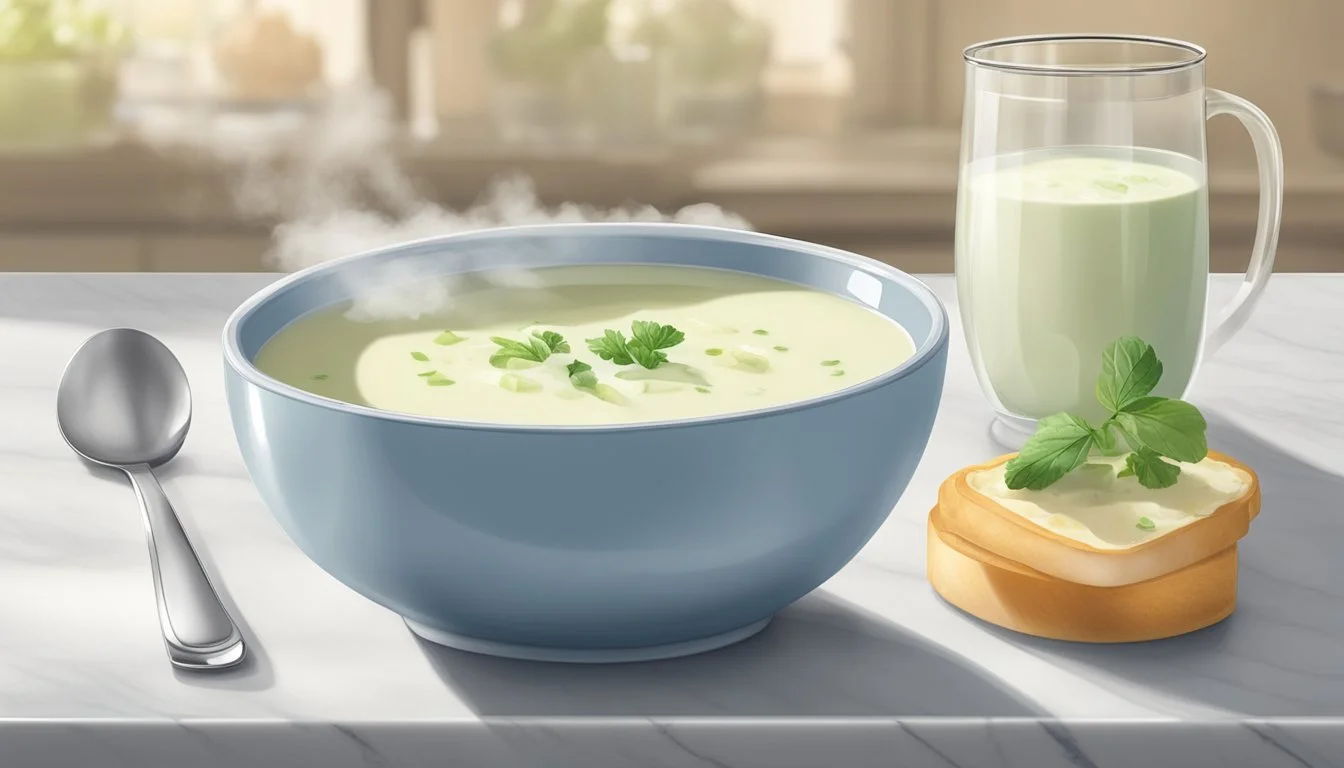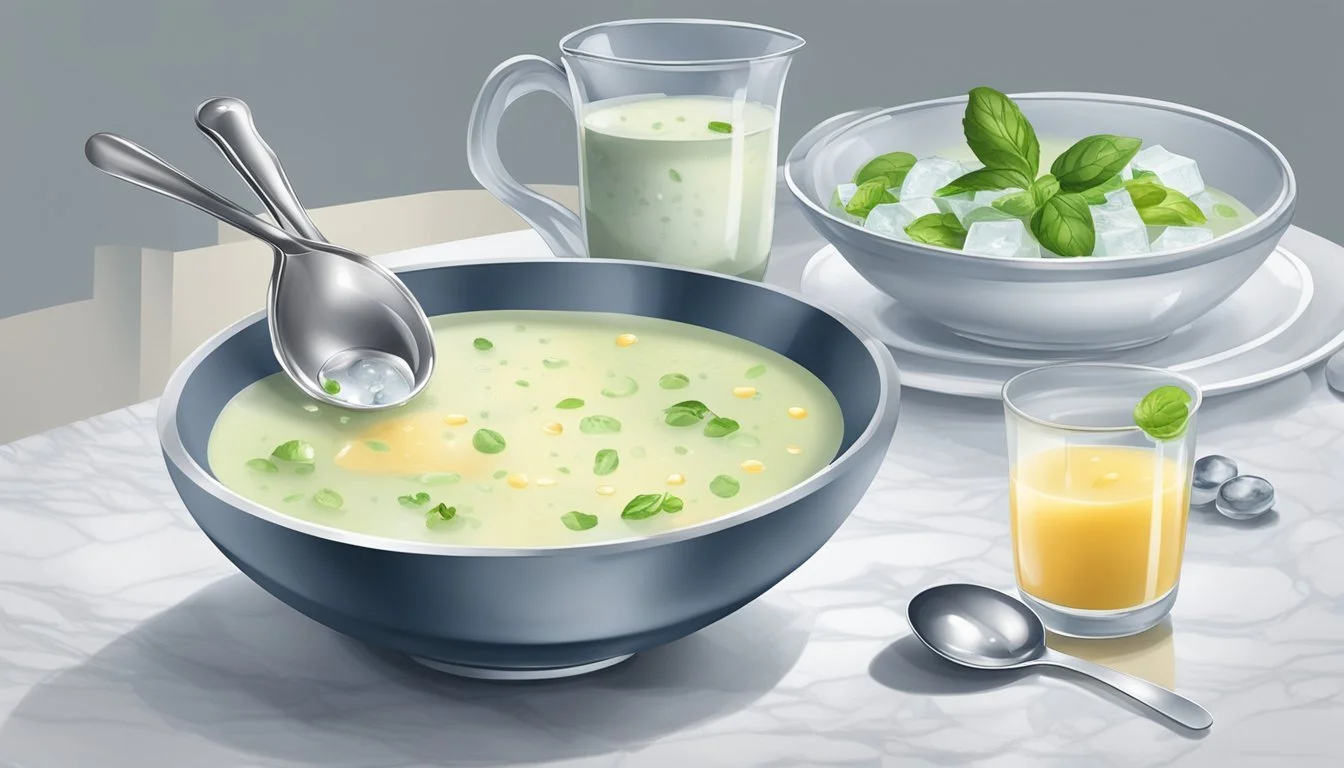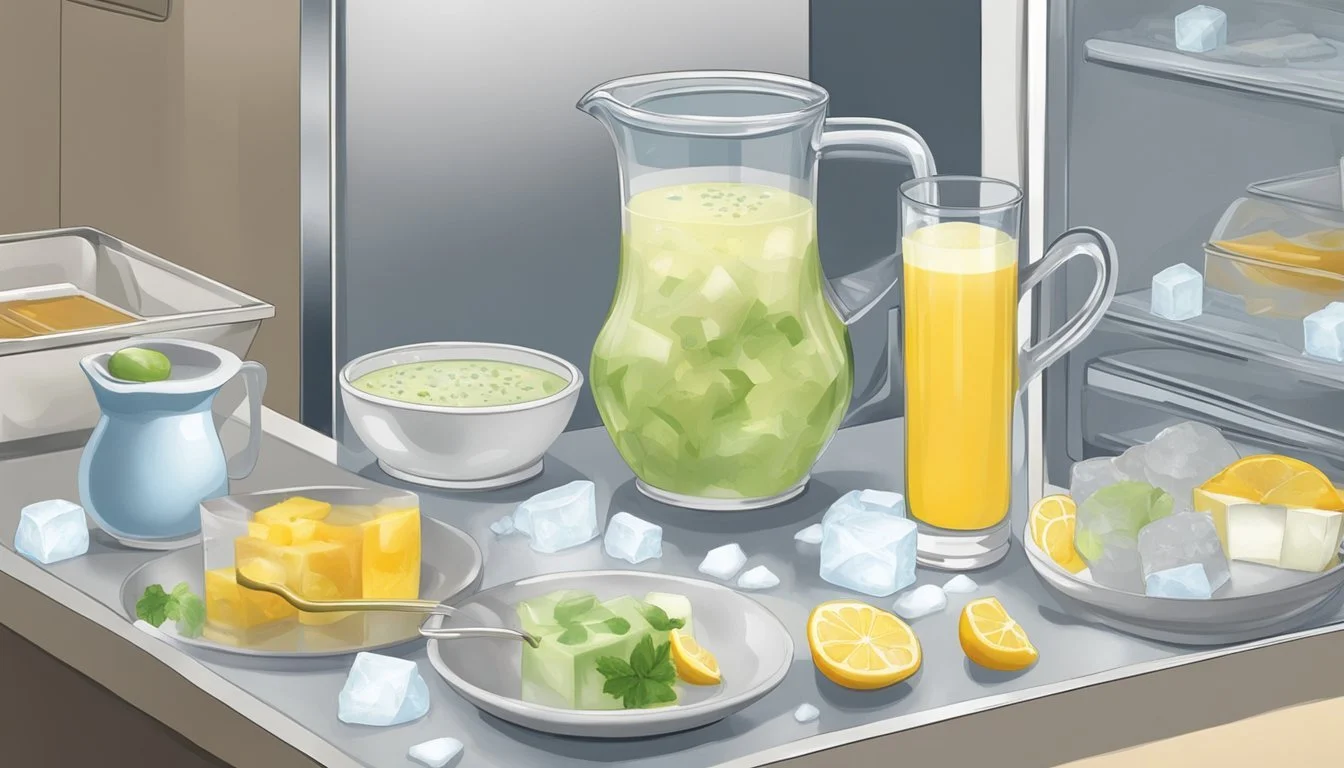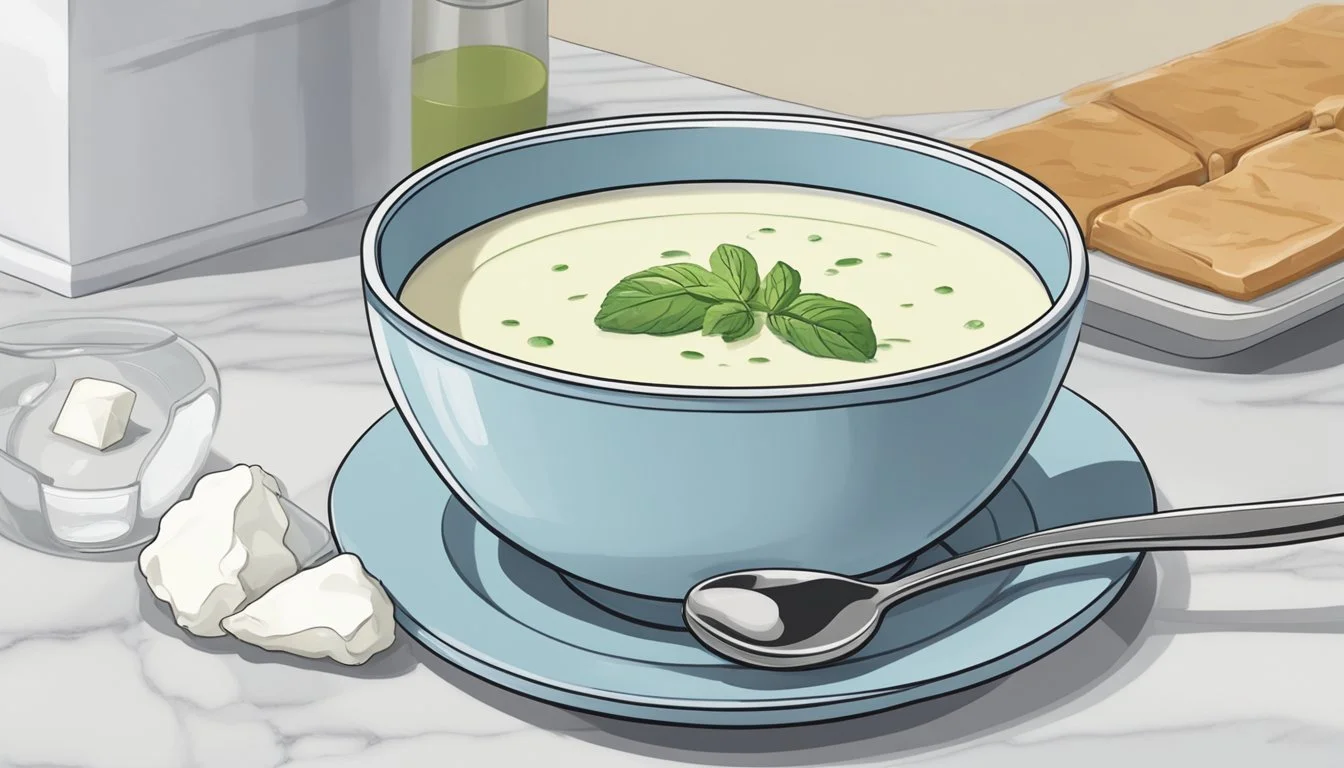Best Way to Reheat Vichyssoise
Techniques for Preserving Chill and Flavor
Vichyssoise, the classic French soup, elegantly graces tables particularly on warm summer days with its chilled, creamy consistency. Traditionally served cold, this pureed soup is a symphony of leeks, potatoes, (What wine goes well with potatoes?) cream, and chicken stock. Its velvety texture and mild flavors are a testament to the culinary finesse inherent in French cuisine. Appreciating vichyssoise requires understanding that its charm lies not only in its simplicity but also in the nuanced balance of its flavors, which should be respected even when reheating or revisiting leftovers.
Reheating vichyssoise may seem counterintuitive given its characteristically chilled serving temperature, but it is not about warming the soup. Instead, it involves gently stirring to evenly distribute the flavors and textures that may have settled during refrigeration. The technique preserves the soup’s intended refreshing coolness while ensuring that every spoonful is as delightful as when it was first prepared.
Maintaining the integrity of vichyssoise calls for restraint and precision, apropos of the care that goes into its initial preparation. Even when serving the next day, the objective is to present a dish where the flavors have melded seamlessly without any compromise to its chilled, creamy essence. Attention to detail in this final stage upholds the soup’s reputation as a culinary classic and ensures a sublime taste experience on any occasion, particularly as a refined accompaniment to a summer meal.
Historical Background
In exploring the best ways to reheat Vichyssoise to maintain its chilled temperature and flavors, it is essential to understand its origins and notable influences. The soup's history is as rich and smooth as its texture, with a lineage that traces back to France and is entwined with the legacy of iconic culinary figures.
Origin of Vichyssoise
Vichyssoise is a French soup with a twist—it's served cold. Louis Diat, a French chef at the Ritz-Carlton in New York, is credited with its creation. The inspiration stemmed from his childhood in France where his mother and grandmother would add milk to the soup to cool it down during the summers. Diat named it "Vichyssoise" in 1917, drawing from Vichy, a town near where he was born.
Julia Child's Influence
Julia Child, an American cooking teacher, author, and television personality, had a profound impact on the popularization of French cuisine, including Vichyssoise, in the United States. Her esteemed cookbook, Mastering the Art of French Cooking, published in 1961, became a touchstone for home cooks eager to explore French cooking. By demystifying French dishes, Child made Vichyssoise accessible to the masses, ensuring its place in the pantheon of French culinary classics.
Essential Ingredients
When creating Vichyssoise, selecting quality ingredients is crucial for a dish that harmonizes taste and texture. The right combination of potatoes, leeks, onions, and dairy not only impacts the flavor but also determines the creamy consistency of the soup.
Choosing the Right Potatoes
For Vichyssoise, Yukon Gold potatoes are often preferred for their optimal balance of starchiness and creaminess, which helps create a smooth and velvety soup. The texture of the potatoes should be dense enough to lend body to the soup without becoming too heavy.
The Role of Leeks and Onions
Leeks are essential for their subtle, sweet undertone, which is a hallmark of Vichyssoise. Using fresh leeks and thinly slicing them ensures a delicate flavor. Onions, on the other hand, can be added for additional depth but should be used sparingly to not overpower the leeks' gentle notes.
Creams and Broths
Dairy is pivotal for the luxurious texture of Vichyssoise. A combination of heavy cream or whipping cream and milk can provide the desired creaminess, while avoiding a consistency that's overly thick. The use of chicken stock or vegetable stock is integral for flavor; homemade or high-quality store-bought stocks are recommended. Kosher salt, and a touch of white pepper, subtly enhances the overall taste profile.
Tools and Equipment
When reheating Vichyssoise, using the right tools can enhance the soup's texture and flavor. A gentle reheating method is paramount to maintain the soup's characteristic creaminess and temperature.
Benefits of an Immersion Blender
An immersion blender offers a convenient way to smooth out Vichyssoise directly in the pot. This tool minimizes cleanup and provides control over the soup's consistency. Users can ensure even blending and a perfect texture, which is crucial for a chilled soup like Vichyssoise.
Using a Regular Blender
A regular blender works well for pureeing Vichyssoise in batches. It's important to use a blender with a robust motor that can handle the soup's thickness. Ensure the lid is secure to prevent spills, but allow steam to escape by removing the center cap and covering with a towel.
Alternative Tools
If neither type of blender is available, other tools can be used. A food processor offers similar pureeing capabilities, but may not achieve as silky a texture. A fine-mesh sieve can help strain the soup to remove lumps. To reheat, use a dutch oven or soup pot, which distributes heat evenly without scorching.
Preparation Techniques
In perfecting the preparation of Vichyssoise, one must focus on the detailed execution of cooking the vegetables, achieving the desired creamy and smooth texture through proper blending, and utilizing effective chilling methods to maintain the soup's signature cold temperature.
Cooking the Vegetables
For a flawless Vichyssoise, one begins by slicing the leeks thinly and evenly to ensure uniform cooking. The potatoes are similarly prepared, with care taken to cut them into consistently sized pieces. These vegetables are then combined in a pot with water, or sometimes a light broth, seasoned with salt, and brought to a gentle boil. The heat is reduced, and the pot is partially covered to allow the leeks and potatoes to simmer. This slow cooking process is crucial, continuing for about 20 to 30 minutes, until the vegetables are tender and imparting their flavors into the liquid, setting the foundation for this classic chilled potato and leek soup.
Blending for Smooth Texture
Upon cooking, the next step is to transform the softened vegetables into a creamy and smooth texture characteristic of Vichyssoise. An immersion blender is the typical tool of choice, puréeing the mixture directly in the pot to a silky consistency. For an even finer texture, the puréed soup can be strained through a fine-mesh sieve to remove any remaining bits, ensuring the soup is luxuriously smooth. This step not only contributes to the texture but also to the harmonious melding of flavors within the soup.
Chilling Methods
The final and arguably most critical step in preparing Vichyssoise is the chilling process. After the vegetable mixture is blended with cream—ranging from light to heavy depending on preference—the soup must be cooled. Initially, it can be allowed to reach room temperature to prevent condensation when covered. Then, it is refrigerated, typically for at least 24 hours. This duration is not merely for cooling but also for allowing the flavors to fully integrate and mature. The result is a chilled soup that can be served with confidence in its taste and texture. Notably, while traditionally consumed cold, some may prefer their Vichyssoise served warm, which is equally acceptable and can be gently reheated without boiling.
By adhering to these preparation techniques, one ensures that the Vichyssoise maintains its integrity and offers a delectable experience with every spoonful.
Seasoning and Flavoring
Proper seasoning and flavoring are crucial to enhancing the taste of Vichyssoise while maintaining its characteristically mild and creamy profile. Freshness and balance should guide the selection of herbs and spices, as well as the careful adjustment of salt and pepper.
Herbs and Spices
In making Vichyssoise, chefs often incorporate a selection of herbs and spices that complement the leek and potato foundation. Thyme is a common choice, providing a subtle earthiness without overpowering the other ingredients. A tablespoon of fresh thyme leaves can be added during cooking to infuse the soup with its aroma.
Fresh chives are typically used as a garnish, providing a mild onion flavor that resonates with the soup's base without the intensity of a French onion soup. Chopped chives sprinkled on top before serving not only add a punch of flavor but also a contrasting color.
Adjusting Salt and Pepper
The use of salt in Vichyssoise should be considered carefully, as it brings out the flavors of the other ingredients. Kosher salt is preferred by many for its pure taste and ease of control during seasoning. Start with a modest amount, such as ½ teaspoon, and adjust according to taste after the soup has cooled, as chilling can slightly mute flavors.
Pepper should be used to enhance, not dominate. A pinch of white pepper is often chosen for its ability to blend seamlessly into the creamy soup, avoiding the specks that black pepper would produce. This choice supports maintaining the classic pale appearance of Vichyssoise while still delivering the desired peppery notes. A comparison is presented below to guide the choice between white and black pepper:
Pepper Type Flavor Profile Visual Impact White Pepper Milder, less assertive Minimal, keeps soup color consistent Black Pepper Sharp, more pronounced Visible specks, adds texture
By carefully selecting and balancing herbs and spices, and finely tuning the levels of salt and pepper, one can ensure that the Vichyssoise retains its chilled creaminess, with flavors that are both harmonious and pronounced.
Health and Dietary Considerations
When reheating Vichyssoise to keep its chilled nature and flavors intact, one must consider the nutritional composition and dietary restrictions of the dish's components.
Analyzing Fat Content
Vichyssoise is traditionally made with potatoes, leeks, and cream, contributing to its richness. The cream is a significant source of saturated fat and cholesterol. To reduce the fat content, one may opt for low-fat or non-fat dairy alternatives without compromising the soup's creamy texture. This adaptation benefits individuals monitoring their saturated fat and cholesterol intake. The soup typically has negligible amounts of trans fat.
Saturated fat: Present primarily in full-fat cream.
Cholesterol: Derived from dairy; can be moderated with substitutes.
Gluten-Free and Vegetarian Options
Vichyssoise can be easily adapted for those following gluten-free and vegetarian diets. Traditional ingredients like potatoes, leeks, and cream are naturally gluten-free. For a vegetarian version, ensure that the soup base, such as a stock or broth, is vegetable-derived instead of chicken or meat-based, which is commonly used in some recipes. This substitution maintains both the vegetarian nature and the soup's nutritional value, offering a good source of dietary fiber from the vegetables, and protein from the dairy components.
Gluten-Free: No gluten-containing ingredients are necessary.
Vegetarian: Replace meat-based stock with vegetable stock.
Serving Suggestions
When Vichyssoise is thoughtfully paired with the right accompaniments and garnishes, one can ensure the dish serves as an exquisite starter or main dish, enhancing the dining experience while respecting its delicate flavor.
Accompaniments and Garnishes
The cold, creamy nature of Vichyssoise pairs excellently with various accompaniments that add texture and contrast:
Crusty Bread: Serve with a slice of toasted, crusty bread for a pleasing crunch.
Garnishes: A sprinkle of finely chopped parsley or a few strips of smoked salmon can add freshness and a hint of luxury.
Crab (What wine goes well with crab?): Delicate crab meat complements the soup’s creamy base without overpowering it.
These additions serve not merely as garnishments but as integral components that elevate the soup's flavor profile.
Serving as a Starter or Main
Whether serving Vichyssoise as a starter or main course will dictate portion size and accompaniments:
As a Starter: Serve in small, elegant bowls, garnished with a light touch, ensuring not to satiate the appetite before the main course, perhaps followed by a dish of roasted chicken (What wine goes well with roasted chicken?) for a complete meal.
As a Main: When featured as the centerpiece for lunch, larger bowls are appropriate, and more substantive pairings, like crab or smoked salmon, provide enough satisfaction for the meal.
Properly curated, Vichyssoise can indeed be a light, yet fulfilling first course or a luxurious standalone lunch.
Storing and Reheating
The proper storage and reheating techniques for vichyssoise ensure this classic French soup retains its creamy texture and layered flavors when enjoyed as leftovers.
How to Store Vichyssoise
After serving vichyssoise, any leftovers should be handled with care to maintain its quality. Steps for storage include:
Cooling: Allow the soup to reach room temperature before storage to prevent bacterial growth.
Transferring: Place the vichyssoise in an airtight container to keep out contaminants and preserve freshness.
Refrigerating: Store the container in the refrigerator promptly. Vichyssoise typically remains fresh for 3-4 days.
If one anticipates a longer delay before consumption, freezing is an option:
Freezing: Pour vichyssoise into a freezer-safe container, leaving some space to allow for expansion as it freezes. Properly frozen, it can be stored for up to one month.
Best Ways to Reheat Without Cooking
Vichyssoise is traditionally served cold, but if one needs to bring it back to the perfect chilled temperature after storage, they can follow these steps:
Defrosting: If vichyssoise is frozen, thaw it in the refrigerator for several hours or overnight.
Chilling: Once the soup is defrosted, or if simply refrigerated, place the vichyssoise back into the refrigerator for a few hours before serving to ensure it's thoroughly chilled.
It is crucial to avoid reheating vichyssoise in a conventional sense, as applying heat will cook the soup and alter its intended flavor and texture.
Alternative Vichyssoise Recipes
Vichyssoise, the classic leek and potato soup served chilled, can be easily adapted with additional vegetables and proteins. These modifications not only alter the flavor profile but can also enhance the soup's nutritional value while still being effortless to make.
Vegetable Variations
Adding different vegetables to the standard vichyssoise recipe can provide a refreshing twist on the traditional French potato soup. A popular alternative includes:
Celery: Incorporate chopped celery for a subtle, earthy flavor and extra crunch.
Peas: Green peas add a sweet note and vibrant color, making the soup more visually appealing.
Both of these vegetables can be sautéed along with leeks and blended to achieve a creamy texture that adheres to the classic vichyssoise characteristics.
High-Protein Additions
For those seeking a filling, high-protein version of vichyssoise, consider the following:
Edamame: Adding shelled edamame beans into the simmering process increases the protein content while infusing an East Asian twist.
Chicken: Incorporate pre-cooked, finely shredded chicken into the blended soup for a more satiating meal.
These protein additions are suited for anyone looking to elevate the traditional recipe into a more hearty and nutritious meal, without compromising on the ease of preparation.
Frequently Asked Questions
When looking to serve Vichyssoise, the soup's temperature and texture are essential considerations. The following subsections address common concerns and provide clear, expert guidance.
Can Vichyssoise Be Served Warm?
Vichyssoise, traditionally served chilled, is a versatile dish that can indeed be served warm. This is because it is a close relative of potage Parmentier, which is typically enjoyed heated. For those who prefer a hearty soup during cooler seasons, gently warming Vichyssoise can transform it into a comforting meal. However, care should be taken to warm it slowly over low heat to preserve its smooth consistency.
Adjustments for Texture Issues
Occasionally, Vichyssoise may become too thick after being refrigerated. If the consistency is denser than desired, adjustments can be made to ensure it maintains the classic smoothness:
If too thick: Slowly stir in small amounts of cream or broth until the desired consistency is reached.
For a smooth consistency: If the soup has separated or is too chunky, one can use an immersion blender to purée it until smooth again.
Always remember that these adjustments should be made with care, preserving the delicate balance of flavors that make Vichyssoise a staple on the summer menu.











